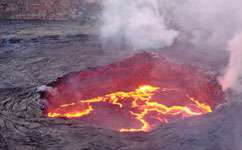Melting in the Afar helps scientists understand how oceans form

Lavas from the Afar Depression in Ethiopia, where three tectonic plates are spreading apart, have given scientists a new insight into how ocean basins form.
The Afar region is geologically unique, as it is the only place in the world where two continents are at the advanced stage of pulling away from each other. Geology tells us that when tectonic plates pull apart like this, the continental crusts usually gets thinner causing a depression to form between them. This often gets filled with a sea or, if the continents break apart altogether, a new ocean basin. By studying this so-called rifting process in the present, geologists hope to better understand how other ocean basins, like the North Atlantic, formed.
The Afar rift is home to numerous volcanoes and the magma the feeds these plays an important role in causing the crust to rift apart. UK and US researchers wanted to understand how and where the magma that causes the rifting in Afar is formed.
'Afar is the best example we currently have of advanced continental rifting – where flowing magma is forcing its way upwards causing the continents to break apart' explains Dr David Ferguson from the Lamont-Doherty Earth Observatory at Colombia University in the USA, who lead the research.
'In recent years we've seen some specific phases where we've seen lots of volcanic eruptions at the same time as lots of magma has intruded between the plates, forcing Africa and Arabia apart. Understanding how this magma is created is integral to understanding the process of tectonic rifting,' he adds.
Published today in Nature, the study found that the Earth's mantle layer directly beneath the rift valley is about 100 C hotter than the mantle beneath other continental regions. The hotter temperature means that there is a sustained supply of magma being created beneath Afar. This then moves upwards to the surface, feeding the many volcanoes at the surface.
'As the mantle is hotter it means it will melt much more easily and percolate up through the rocks. That explains why there are so many volcanoes,' says Dr Derek Keir from NERC's National Oceanography Centre, co-author on the study.
The researchers also found that the tectonic plates were thicker at the point where they were spreading than expected.
'If you take a continent and spread it apart, if the initial rift is 100km wide and then it extends to 400 km wide, like we saw at the Red Sea, it's opened by a factor of four times. So, you would expect the plates to be four times thinner - just like if you stretch a piece of toffee it gets thinner,' explains Keir.
'But here we see it's much thicker. We think that's because the plate cools as it extends and this maintains its thickness.'
The rift is approaching the age where it should form an oceanic basin, so it should be very thin by now.
'The thickness doesn't mean a new ocean basin won't form anytime soon but it does mean at some point the African plate will have to be thinned and stretched very quickly,' says Ferguson.
The team now hope to extend this study across entire regions, so that they can better understand how whole tectonic plates deform when continents break into two parts.
More information: www.nature.com/nature/journal/ … ull/nature12292.html
Journal information: Nature
Provided by PlanetEarth Online
This story is republished courtesy of Planet Earth online, a free, companion website to the award-winning magazine Planet Earth published and funded by the Natural Environment Research Council (NERC).

















